North Kalimantan is home to a wide variety of birds, with over 300 species of birds recorded in the province. The birds of North Kalimantan are diverse and range from resident species, such as the kingfisher, to migratory species, such as the oriental dollar bird.
The lush tropical habitat of the province provides an excellent home for these feathered friends, and the abundance of food makes it an ideal destination for bird-watching.
Whether you’re a bird enthusiast or just looking to appreciate the beauty of nature, North Kalimantan is the perfect place for you.
24 Birds to Watch in North Kalimantan
North Kalimantan is a province in Indonesia that is located on the island of Borneo. It is a haven for bird lovers, as it hosts over 300 species of birds, many of which are endemic or rare.
The province has a variety of habitats, from lowland forests to mangroves and wetlands, that support a diverse range of birdlife. Whether you are a beginner or an expert, you will find something to marvel at in North Kalimantan.
Here are 24 birds that you should not miss when you visit this amazing place.
1. Yellow-vented Bulbul
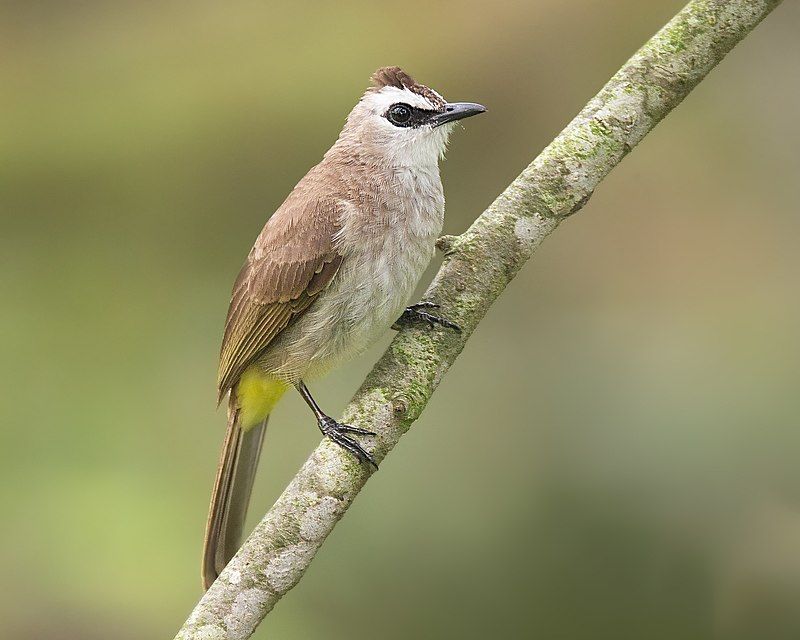
The yellow-vented bulbul is a species of passerine bird belonging to the bulbul family. This species is native to southeastern Asia, particularly Indochina and the Philippines.
They are not found in deep forests but in open habitats such as grasslands, scrublands, agricultural fields, and urban gardens. This species is a resident breeder, meaning it remains in the same area all year round and does not migrate.
The yellow-vented bulbul is a very adaptable species and can be seen in various habitats, from woodlands to mangroves and even city parks. It is also a very vocal species, often seen singing and calling from treetops.
Its diet includes fruits, berries, insects, and sometimes even small reptiles. The yellow-vented bulbul is an integral part of the ecosystem, helping to disperse seeds and control insect populations.
| Kingdom | Animalia |
| Phylum | Chordata |
| Class | Aves |
| Order | Passeriformes |
| Family | Pycnonotidae |
| Genus | Pycnonotus |
| Species | P. goiavier |
2. Crested Partridge
The Crested Partridge is a gamebird species belonging to the Phasianidae family of the Galliformes order. It is an omnivorous bird found mainly in Southeast Asia and is the only known species of the genus Rollulus.
Various names, such as the Roul-Roul, Red-Crowned Wood Partridge, Green Wood-Quail, and Green-Wood Partridge, also know this species. The Crested Partridge is a medium-sized bird between 30 and 35 cm long.
It has a long tail and a distinctive crest on its head. Its plumage is mainly brownish-gray with some lighter spots and streaks, and there is also a red patch on its forehead.
The males and females are similar in appearance. However, the males tend to have more prominent crests. The Crested Partridge is an omnivore, meaning it eats various foods, including seeds, fruits, insects, and small animals.
It can be seen foraging in grassy areas and woodlands and prefers to stay close to the ground.
They are usually found in pairs or small groups and are known to make loud calls when disturbed. The Crested Partridge is an essential species in the wild, providing food for other animals such as snakes, owls, hawks, and foxes.
Humans also hunt it for its meat and feathers, which are used for decorative purposes. The species is listed as Least Concern on the IUCN Red List, and its population is considered stable.
| Kingdom | Animalia |
| Phylum | Chordata |
| Class | Aves |
| Order | Galliformes |
| Family | Phasianidae |
| Genus | Rollulus |
| Species | R. rouloul |
3. Zebra Dove
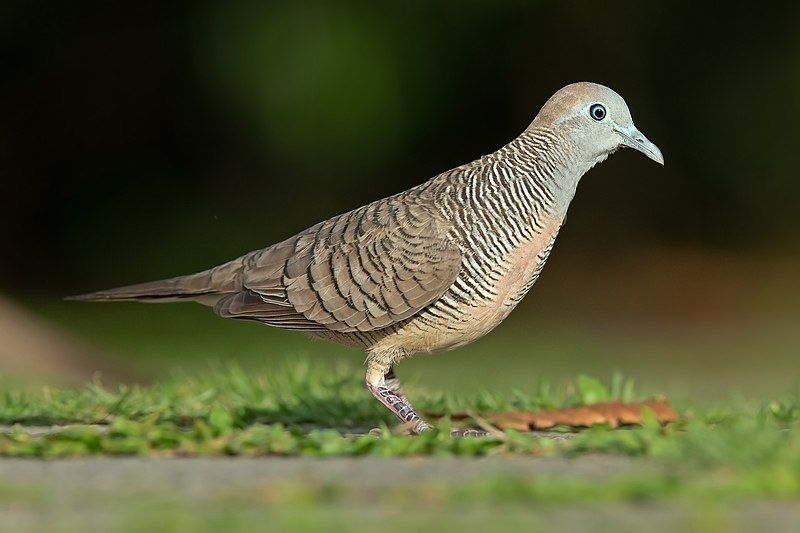
The zebra dove is a Southeast Asian bird belonging to the Columbidae family. This type of dove is relatively tiny, with a long tail and a predominantly brownish-grey coloring pattern, with black-and-white barring along its wings and body.
This particular pattern gives the bird its distinctive name, as the stripes resemble a zebra. Various names, including the barred ground dove and the barred dove, know the zebra dove.
It is found mainly in open woodlands and is common in tropical regions. It is an omnivore, meaning it will feed on various types of food, such as insects, fruits, and seeds.
The zebra dove is often seen in pairs or small groups and is known to be a shy and retiring bird. The zebra dove is considered a symbol of peace, love, and harmony in many cultures. It is often seen in Hindu and Buddhist art and other religious artwork.
It is also a famous pet bird due to its attractive coloring and friendly nature. The zebra dove is an essential species in the Columbidae family, and its presence reminds us of the beauty and importance of biodiversity.
| Kingdom | Animalia |
| Phylum | Chordata |
| Class | Aves |
| Order | Columbiformes |
| Family | Columbidae |
| Genus | Geopelia |
| Species | G. striata |
4. Pink-necked Green Pigeon
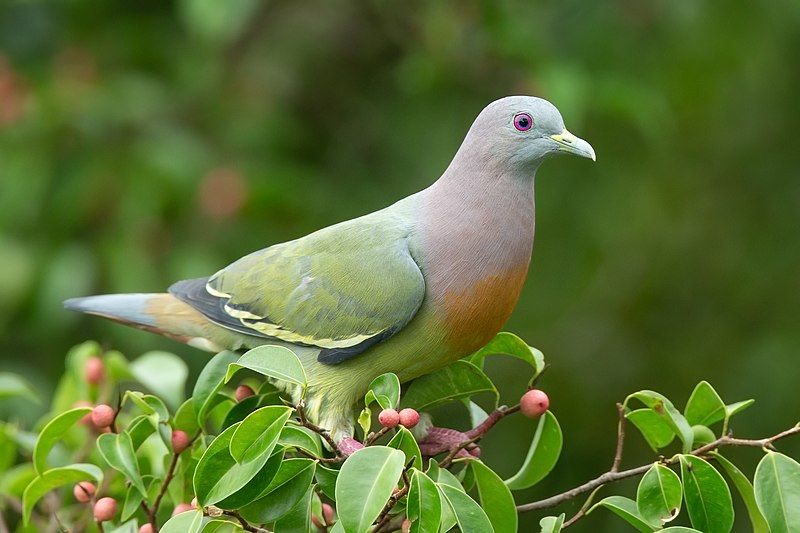
The pink-necked green pigeon is a species of avian found in Southeast Asia. It is a member of the Columbidae family, which includes both pigeons and doves.
The bird is found in various habitats, from Myanmar and Vietnam to the islands of Indonesia and the Philippines. It is a common species found in forests, mangroves, and urban parks.
The bird is easily identified by its bright green plumage and pink neck collar. It feeds on seeds and fruit and is typically seen in small flocks.
The pink-necked green pigeon is an integral part of the local ecosystem, helping to disperse seeds and pollinate many plants.
| Kingdom | Animalia |
| Phylum | Chordata |
| Class | Aves |
| Order | Columbiformes |
| Family | Columbidae |
| Genus | Treron |
| Species | T. vernans |
5. Lesser Whistling Duck
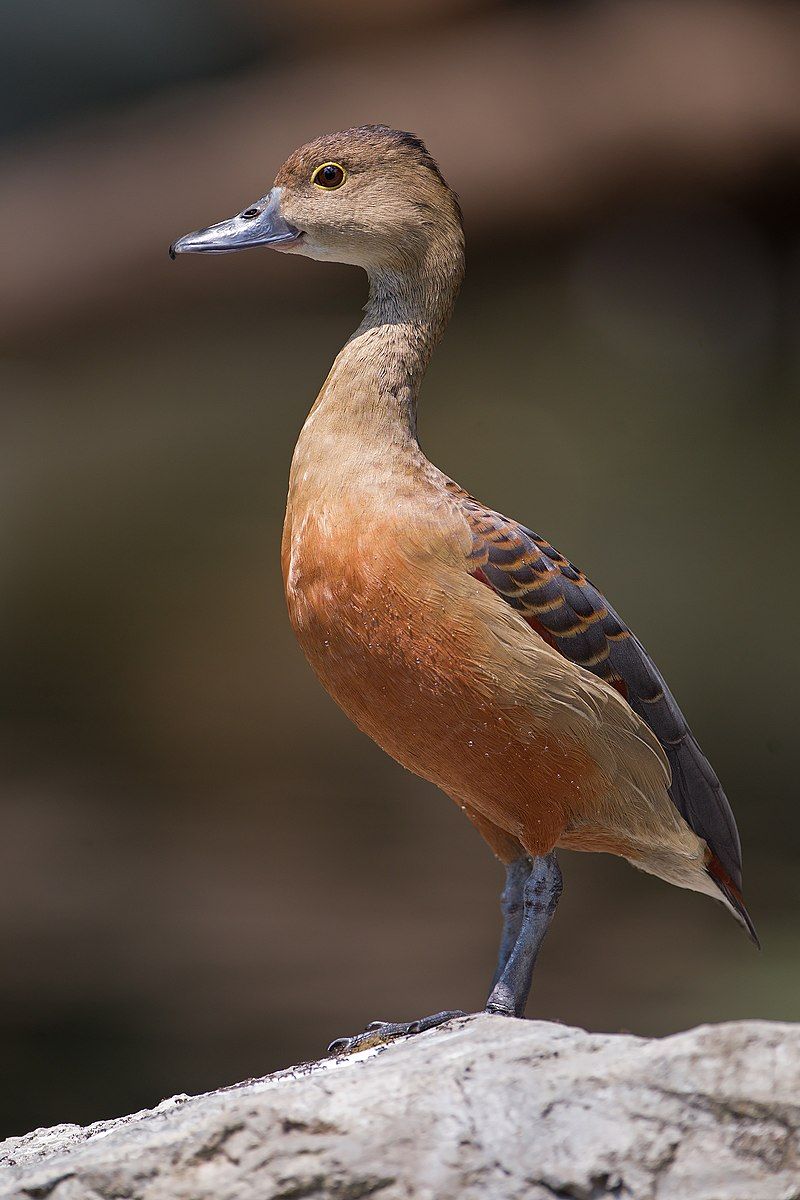
The lesser whistling duck is found in the Indian subcontinent and Southeast Asia. This particular duck species is called the Indian whistling duck or the lesser whistling teal.
They are primarily nocturnal animals, meaning that they feed mainly at night. During the day, they can often be seen in large flocks around lakes and wet paddy fields. The lesser whistling duck is an omnivorous species, meaning they feed on various plants and animals.
They have been known to consume various grains, nuts, insects, and even small fish. They also feed on different fruits, including mangoes and bananas.
The lesser whistling duck is an essential species in many parts of its range, as it helps regulate the populations of insect pests and spreads crucial nutrients in the environment.
| Kingdom | Animalia |
| Phylum | Chordata |
| Class | Aves |
| Order | Anseriformes |
| Family | Anatidae |
| Genus | Dendrocygna |
| Species | D. javanica |
6. Spotted Dove
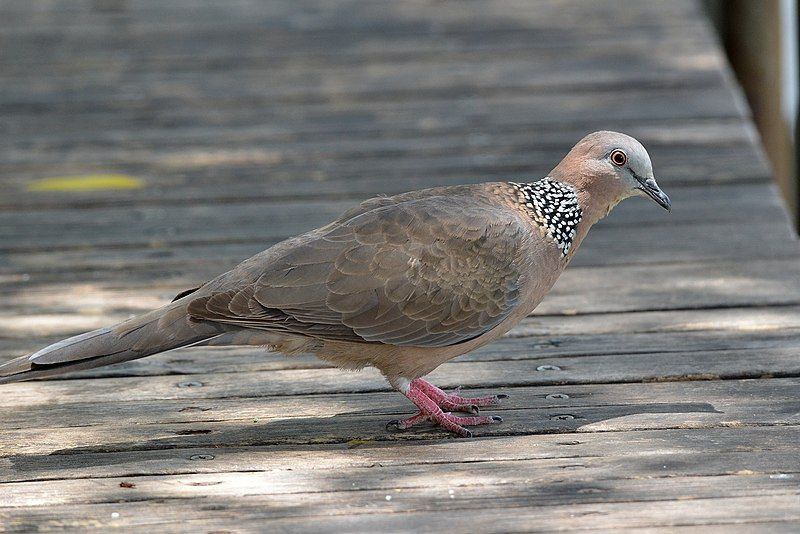
The spotted dove is a species of small pigeon found throughout the Indian subcontinent and Southeast Asia. It has a reasonably long tail compared to other pigeons and is a common resident bird in its native range.
The species has spread to many other regions of the world and has established itself in these areas, forming feral populations. This is likely due to the species’ ability to adapt to different environments and its popularity as a pet bird.
Its diet typically consists of tiny seeds and insects, and it can be found in various habitats, such as grasslands, open woodlands, and urban gardens.
The spotted dove is a valuable bird to various ecosystems, helping to disperse seeds and keep insect populations in check.
| Kingdom | Animalia |
| Phylum | Chordata |
| Class | Aves |
| Order | Columbiformes |
| Family | Columbidae |
| Genus | Spilopelia |
| Species | S. chinensis |
7. Greater Coucal
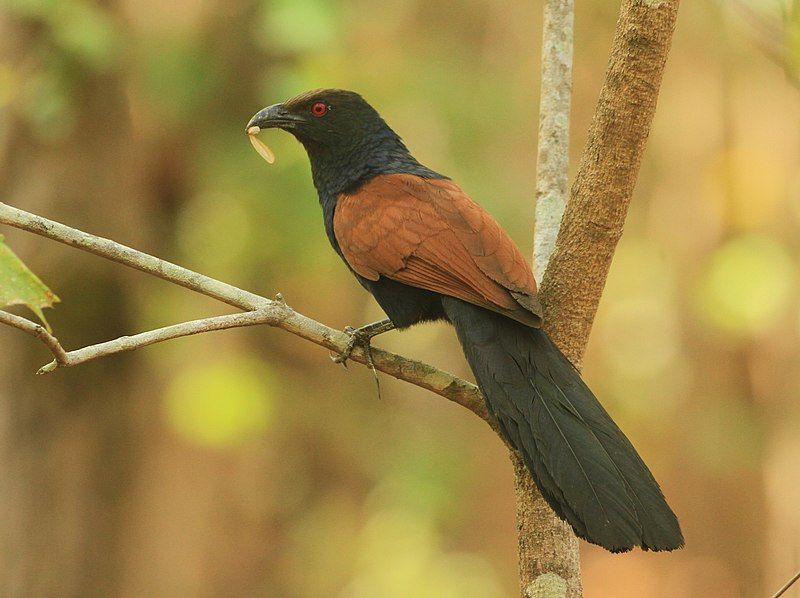
The greater coucal, also known as the crow pheasant, is a species of bird belonging to the Cuculiformes order. This order includes birds such as cuckoos, roadrunners, and hoatzins.
The greater coucal is a large bird and is not a parasitic species, meaning it does not lay its eggs in other birds’ nests. It is a widespread resident in the Indian Subcontinent and Southeast Asia and is divided into several subspecies.
Some of these subspecies are considered entire species in their own right. The greater coucal is a solitary bird that inhabits dense vegetation, such as forests, jungles, and grasslands.
It is omnivorous, eating plant and animal matter, such as fruits, insects, and small rodents. It is an active bird, usually seen perched on branches or flying across open areas. Its loud, repetitive call can be heard in the early morning and late evening.
| Kingdom | Animalia |
| Phylum | Chordata |
| Class | Aves |
| Order | Cuculiformes |
| Family | Cuculidae |
| Genus | Centropus |
| Species | C. sinensis |
8. Rock Dove
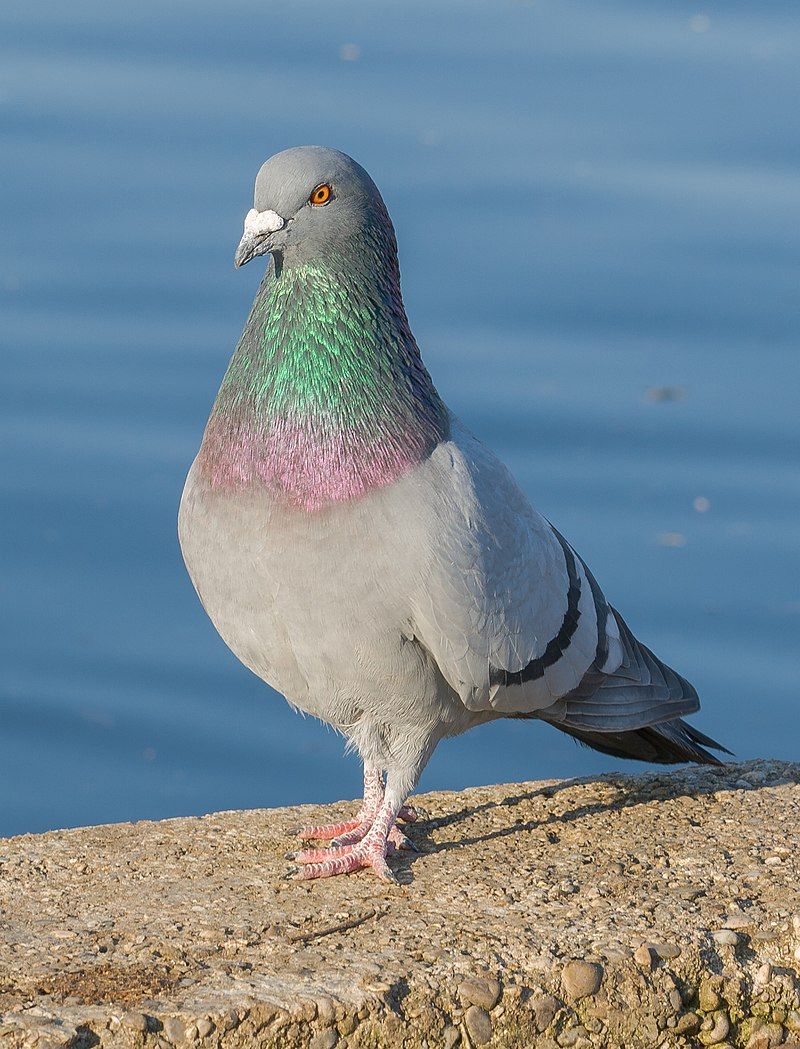
The rock dove, also known as the rock pigeon or common pigeon, is a species of bird belonging to the Columbidae family. It is commonly referred to as the “pigeon.”
The domestic pigeon is a descendant of the rock dove, and its populations have increased exponentially due to the escape of domestic pigeons into the wild. As a result, there are now large numbers of feral pigeons living around the world.
These feral pigeons are a direct result of the domestication of the rock dove.
| Kingdom | Animalia |
| Phylum | Chordata |
| Class | Aves |
| Order | Columbiformes |
| Family | Columbidae |
| Genus | Columba |
| Species | C. livia |
9. Common Sandpiper
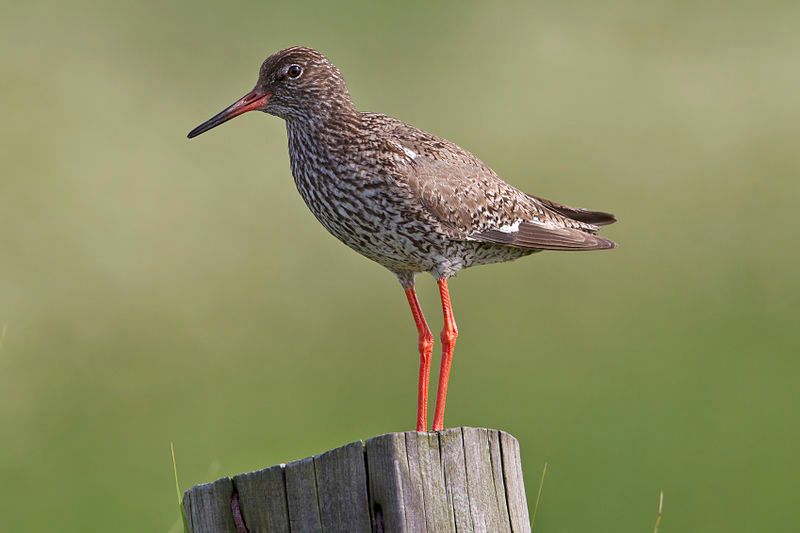
The Common Redshank, or simply Redshank, is a bird native to Eurasia. It is classified as a wader, a bird that feeds by wading in the water.
Redshanks are a part of the Scolopacidae family, a large family of shorebirds that includes around 87 species. Redshanks are small to medium-sized waders with 25 and 30 cm long and a wingspan of 45 and 50 cm.
They have reddish-brown plumage on their upper parts and white underparts. They have a distinctive long red-orange leg, which is how they got their name, and a long, pointed bill. Their diet consists of insects, crustaceans, and other small aquatic creatures.
Redshanks are usually found in wetlands, estuaries, and coastal mudflats. They can also be found in some inland habitats, particularly during migration. Redshanks are a migratory species and can be seen in large flocks during their spring and autumn migrations.
| Kingdom | Animalia |
| Phylum | Chordata |
| Class | Aves |
| Order | Charadriiformes |
| Family | Scolopacidae |
| Genus | Tringa |
| Species | T. totanus |
10. Crimson-headed Partridge
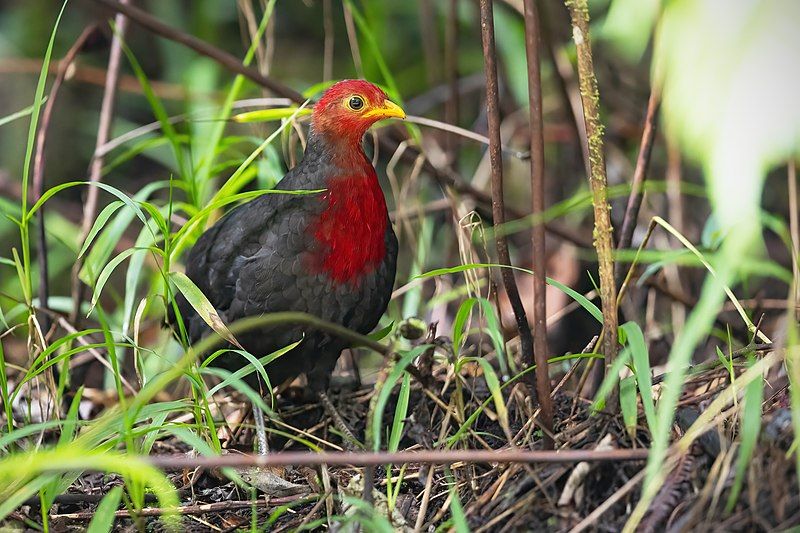
The crimson-headed partridge is an exciting bird belonging to the family Phasianidae, which includes pheasants, partridges, and francolins.
This species was first described by the British ornithologist Richard Bowdler Sharpe in 1879 and is the only species in the genus Haematortyx. The crimson-headed partridge is a medium-sized bird with a stunningly bright red head and neck, blackish-brown wings, and a white-spotted black back.
Its eyes are a bright yellow, and its beak and legs are yellowish-brown. The male and female birds look very similar, except the male has a more vibrant red head and neck. The crimson-headed partridge is found in India, Sri Lanka, Bangladesh, Nepal, and Bhutan.
It lives in grasslands and scrub forests, where it feeds on insects, fruit, and seeds.
The birds typically roost on tree branches and are social creatures, often gathering in small groups. The crimson-headed partridge is a fairly common bird, although its population is decreasing due to habitat destruction.
To help protect this species, conservationists are working to create protected areas and to encourage people to limit hunting and trapping.
With the proper measures, the crimson-headed partridge can continue to be a beautiful fixture in the grasslands and forests of India, Sri Lanka, Bangladesh, Nepal, and Bhutan.
| Kingdom | Animalia |
| Phylum | Chordata |
| Class | Aves |
| Order | Galliformes |
| Family | Phasianidae |
| Genus | Haematortyx |
| Species | H. sanguiniceps |
11. Green Imperial Pigeon
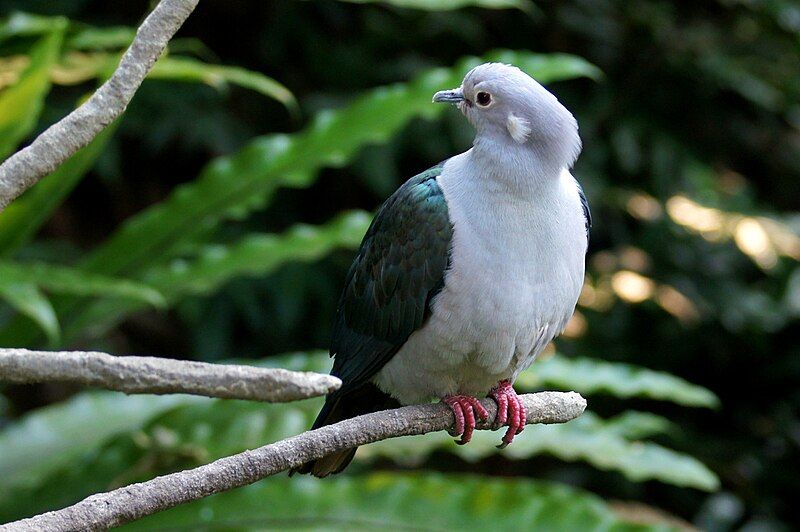
The green imperial pigeon is a species of large forest pigeon found in a wide range of territory stretching from Nepal in the west to southern India, Sri Lanka, southern China, Indonesia, and the Philippines in the east.
This species of pigeon is known for its large size and is a common sight in many of the forests of these countries, as it is one of the most common species of pigeon found in the region. The green imperial pigeon is a predominantly herbivorous bird, feeding mainly on wild fruits, seeds, and buds.
It is also known to feed on invertebrates, such as snails and insects, occasionally. The green imperial pigeon is highly social and is usually found in flocks of up to several hundred individuals.
It is an important bird species in the forests of its range and is an essential food source for many local predators. The green imperial pigeon is a species of conservation concern and is listed as Vulnerable on the IUCN Red List.
It is threatened by habitat loss and degradation due to human activity and hunting and trapping for food. Conservation efforts are needed to ensure the long-term survival of this species.
| Kingdom | Animalia |
| Phylum | Chordata |
| Class | Aves |
| Order | Columbiformes |
| Family | Columbidae |
| Genus | Ducula |
| Species | D. aenea |
12. Little Cuckoo-dove
The little cuckoo-dove is a species of bird in the family Columbidae, characterized by its reddish-brown coloring. This bird is found in Brunei, China, Indonesia, Laos, Malaysia, Myanmar, Thailand, and Vietnam.
It is classified as a species of “Least Concern” by the International Union for Conservation of Nature Red List of Endangered Species.
This means that the species is not considered to be under immediate threat of extinction. The little cuckoo-dove is generally found in tropical and subtropical forests and in the margins of cultivated areas. It feeds on fruits, buds, and flower nectar.
It usually nests in low trees or shrubs and lays its eggs in a flimsy nest built from twigs and grass.
The chicks are altricial, meaning they are born helpless and require care from both parents. Despite its wide distribution and relative abundance, the future of the little cuckoo-dove is by no means certain.
Unsustainable logging practices, agricultural expansion, and urban development contribute to the species’ decline. Conservation efforts must be taken to ensure that this species of bird is not pushed to the brink of extinction.
| Kingdom | Animalia |
| Phylum | Chordata |
| Class | Aves |
| Order | Columbiformes |
| Family | Columbidae |
| Genus | Macropygia |
| Species | M. ruficeps |
13. Bornean Ground Cuckoo
The Bornean ground cuckoo is a large, terrestrial species that can only be found on the island of Borneo. It belongs to the family Cuculidae and is endemic to the sections of the island belonging to Brunei, Malaysia, and Indonesia.
This type of cuckoo prefers a humid forest environment. However, its habitat is currently under threat due to the loss of land. As a result, this cuckoo species is now considered endangered and is at risk of disappearing from its native home.
Human activities such as deforestation and urbanization have caused a significant decline in the species’ habitat, leaving them with limited safe places to live. In addition, hunting and the illegal pet trade have also contributed to its decline.
The Bornean ground cuckoo could soon become extinct if the decline is not reversed. Conservation efforts must be implemented to protect the species and its habitat.
This includes increasing public awareness about preserving the cuckoo’s habitat and creating protected areas where they can safely live and breed.
In addition, research into the species’ ecology and biology could help inform management decisions and provide a better understanding of the species’ needs.
| Kingdom | Animalia |
| Phylum | Chordata |
| Class | Aves |
| Order | Cuculiformes |
| Family | Cuculidae |
| Genus | Carpococcyx |
| Species | C. radiceus |
14. Wandering Whistling Duck
The Wandering Whistling Duck is a species of duck found primarily in tropical and subtropical regions of Australia, the Philippines, Borneo, Indonesia, Papua New Guinea, and the Pacific Islands.
The Wandering Whistling Duck is unique in that it is the only species of whistling duck in the world.
As its name suggests, it is known for its distinctive whistling call that can be heard at night or in the early morning. The Wandering Whistling Duck can be seen in various habitats such as wetlands, shrublands, woodlands, and grasslands.
It feeds mainly on aquatic insects, crustaceans, other invertebrates, and some plant matter.
Scavenging crops, such as rice, maize, and sugarcane, supplement its diet. The Wandering Whistling Duck is a social species often seen in small groups. They sometimes form large flocks when they migrate.
These flocks can consist of up to several thousand birds.
The Wandering Whistling Duck is a long-distance migrant, often traveling great distances between their summer breeding grounds and wintering grounds. The Wandering Whistling Duck is considered a species of Least Concern by the International Union for Conservation of Nature.
However, its numbers are declining due to destroying its habitat, hunting, and introducing invasive species. It is also vulnerable to climate change, affecting its ability to migrate and access food sources.
| Kingdom | Animalia |
| Phylum | Chordata |
| Class | Aves |
| Order | Anseriformes |
| Family | Anatidae |
| Genus | Dendrocygna |
| Species | D. arcuata |
15. Emerald Dove
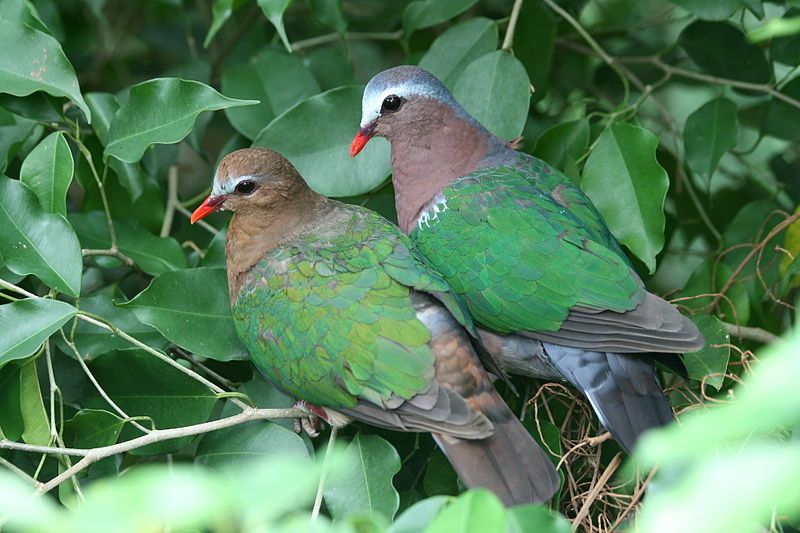
The emerald dove is a pigeon species native to the tropical and subtropical parts of the Indian Subcontinent and Southeast Asia. It is also known as the common emerald dove, Asian emerald dove, grey-capped emerald dove, green dove, and green-winged pigeon.
This dove species is a widespread resident breeding bird, meaning it does not migrate but breeds in its home range. The emerald dove is known for its vibrant green plumage and ability to fly long distances.
Its diet consists mainly of seeds, fruits, and vegetation. In addition to its vibrant green plumage, the emerald dove has a grey cap and a bright red eye on its head. This dove species is known for its peaceful demeanor, making it a famous pet bird.
| Kingdom | Animalia |
| Phylum | Chordata |
| Class | Aves |
| Order | Columbiformes |
| Family | Columbidae |
| Genus | Chalcophaps |
| Species | C. indica |
16. Crested Fireback
The Bornean crested fireback is a pheasant species native to the islands of Borneo and Bangka Belitung. It is the type species of the genus Lophura, meaning it is the species upon which the whole genus is based.
Before 2023, the Bornean crested fireback was referred to as the crested fireback, as the Malayan crested fireback was grouped with it. However, in 2023, they were split into two separate species.
This is because they have some distinguishing physical differences, such as the coloration and size of their feathers. The Malayan crested fireback is smaller than the Bornean crested fireback, while the latter has a more reddish-brown coloration.
This split means that the two species can now be identified more accurately.
| Kingdom | Animalia |
| Phylum | Chordata |
| Class | Aves |
| Order | Galliformes |
| Family | Phasianidae |
| Genus | Lophura |
| Species | L. ignita |
17. Cotton Pygmy Goose
The Cotton Pygmy Goose, also known as the Cotton Teal, is a small species of perching duck native to Asia, Southeast Asia, and parts of Australia.
This species is known for its distinct white quills, often called the White-Quilled Pygmy Goose in Queensland, Australia. They usually inhabit still or slow-moving waters, such as ponds, marshes, and lakes.
The Cotton Pygmy Goose is an omnivorous species whose diet consists mainly of aquatic vegetation, insects, and small fish. During the breeding season, they are known to build their nests near water and usually lay between five to seven eggs.
They tend to be exceptionally social and are often seen in large groups. The Cotton Pygmy Goose is a hardy species well-adapted to its environment.
They are considered the least concerned on the conservation status list and can be found in many parts of Asia and Australia.
| Kingdom | Animalia |
| Phylum | Chordata |
| Class | Aves |
| Order | Anseriformes |
| Family | Anatidae |
| Genus | Nettapus |
| Species | N. coromandelianus |
18. Lesser Coucal
The lesser coucal is a species of cuckoo found in the family Cuculidae. This species is widely distributed across many regions and can overlap with other species. The lesser coucal prefers to live in marshy, grassy, and tree-covered habitats.
This kind of terrain provides the bird with plentiful food sources, and the concealment of the tree cover makes for a safe nesting environment. The grassy areas also offer a safe place for birds to forage and move around without being seen.
The presence of trees also gives the coucal a place to perch and watch for predators. The marshy land is also ideal for the coucal’s breeding season as it provides a place for them to build their nest and lay their eggs.
The presence of grass and trees also ensures the couple has plenty of food to eat while raising their young.
| Kingdom | Animalia |
| Phylum | Chordata |
| Class | Aves |
| Order | Cuculiformes |
| Family | Cuculidae |
| Genus | Centropus |
| Species | C. bengalensis |
19. Little Green Pigeon
The little green pigeon is a bird species belonging to the family Columbidae. It is native to Brunei, Indonesia, Malaysia, Singapore, and Thailand.
The little green pigeon is typically found in subtropical or tropical moist lowland forests, where it can find plenty of food sources and vegetation to shelter itself.
This pigeon species is smaller than other species belonging to the genus Treron, a group of pigeons found in this region of the world. The little green pigeon is known for its vibrant green plumage, which helps it to stand out in its natural habitat.
This bird species also has a wide variety of calls and noises, which it uses to communicate with other members of its flock.
| Kingdom | Animalia |
| Phylum | Chordata |
| Class | Aves |
| Order | Columbiformes |
| Family | Columbidae |
| Genus | Treron |
| Species | T. olax |
20. Chestnut-breasted Malkoha
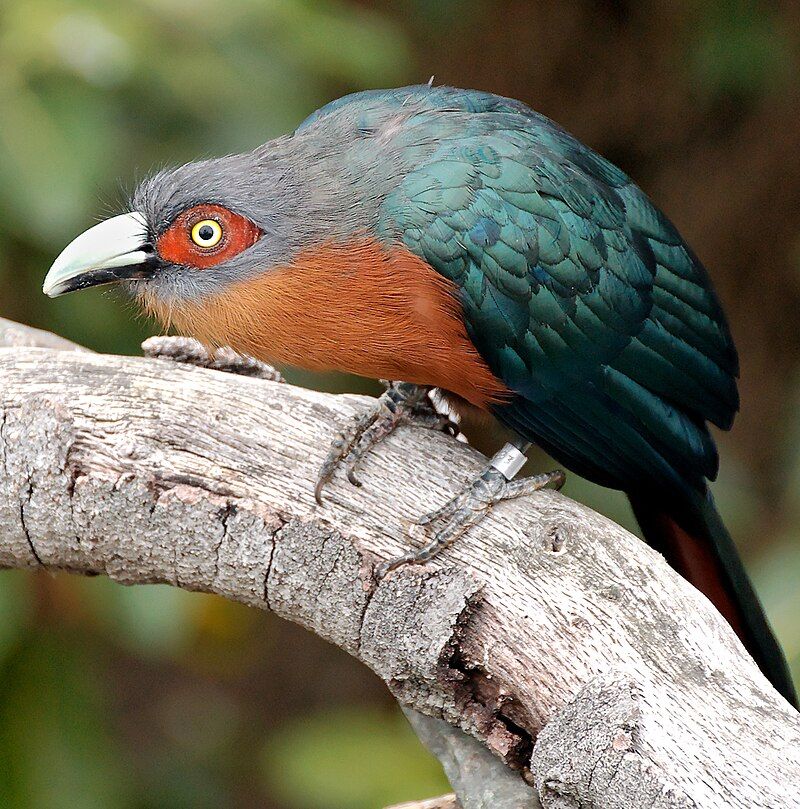
The chestnut-breasted malkoha is a species of cuckoo that inhabits the Southeast Asian region from Myanmar to Java, the Philippines, and Borneo. It is a large bird, measuring up to 49 cm in length, and has a distinct appearance.
The upper parts of the bird are grey and dark green, while the underparts are chestnut in color. It has a large, curved, pale upper bill and a long tail with a bright yellow tip.
The chestnut-breasted malkoha feeds mainly on insects, and its diet can consist of beetles, grasshoppers, caterpillars, and dragonflies. It can also eat small fruits and berries.
This cuckoo species is known to inhabit lowland forests, especially in hilly regions and open woodland and plantations.
The chestnut-breasted malkoha is an essential species for the conservation of Southeast Asian forests, as it helps to control the population of insect pests.
It is also an important species for the region’s local economies, as it is hunted for food and its feathers, which are used in traditional cultural ceremonies.
Despite its importance, the International Union for Conservation of Nature considers the chestnut-breasted malkoha near threatened.
| Kingdom | Animalia |
| Phylum | Chordata |
| Class | Aves |
| Order | Cuculiformes |
| Family | Cuculidae |
| Genus | Phaenicophaeus |
| Species | P. curvirostris |
21. Great Argus
The Great Argus is a large bird species in Southeast Asia belonging to the pheasant family. It is a colorful bird with a long, pointed tail and a distinctive crest of feathers on its head.
The Great Argus is sometimes mistaken for the two species of Crested Argus, which are members of the genus Rheinardia. These birds are similar in appearance to the Great Argus but have a shorter tail and a smaller crest of feathers.
The Crested Argus is found in a much smaller area than the Great Argus, mostly restricted to the island of Sumatra. Both species of Crested Argus are much rarer than the Great Argus and are classified as vulnerable on the IUCN Red List.
| Kingdom | Animalia |
| Phylum | Chordata |
| Class | Aves |
| Order | Galliformes |
| Family | Phasianidae |
| Genus | Argusianus |
| Species | A. argus |
22. Metallic Pigeon
The metallic pigeon, also known as the white-throated pigeon, is a species of bird found within the Columbidae family. It is a medium-sized bird, typically reaching a length of up to 37 cm.
It is easily distinguishable by its unique metallic sheen, which gives it an almost iridescent appearance. The white-throated pigeon is found in various habitats, such as tropical and subtropical forests, parks, gardens, and woodlands.
Its diet consists mainly of fruit, seeds, and nuts. It is also known to feed on small insects and worms. The bird is popular with birdwatchers due to its stunning metallic coloration and graceful movements.
It is also known to be quite vocal, producing a variety of whistles, coos, and other sounds. The metallic pigeon is sexually dimorphic, with males having a brighter metallic coloration than females.
The species is monogamous, and males tend to be territorial, defending their territories and mates against potential threats. Overall, the metallic pigeon is attractive because its unique metallic coloration can be quickly identified.
While it is mainly found in tropical and subtropical regions, it can also be found in parks, gardens, and woodlands. Its diet consists primarily of fruit, seeds, and nuts, and it is known to be quite vocal, producing a variety of whistles, coos, and other sounds.
| Kingdom | Animalia |
| Phylum | Chordata |
| Class | Aves |
| Order | Columbiformes |
| Family | Columbidae |
| Genus | Columba |
| Species | C. vitiensis |
23. Wreathed Hornbill
The wreathed hornbill is an Old World tropical bird that belongs to the hornbill family Bucerotidae. The bar-pouched wreathed hornbill is commonly called because of its identifying blue-black band on its lower throat sac.
This band gives the wreathed hornbill a distinctive look compared to other species of hornbills. The wreathed hornbill is a large bird, typically measuring around 70 cm long and weighing between 1 and 2 kg.
It has a thick bill slightly curved downwards, with a casque on top. The bill is yellow or orange, and the casque is black. The wreathed hornbill’s head, neck, and chest are generally black, while its back, wings, and tail are grey.
The lower throat sac, which is the area where the blue-black band is located, is white. The wreathed hornbill is native to the tropical regions of the Old World, such as India, Southeast Asia, and parts of Africa.
It is primarily found in dense forests, where it feeds on insects, small mammals, and fruits. It is an active and loud bird whose characteristic call is a loud series of “cuk, cuk, cuk” sounds.
The wreathed hornbill is an essential species in the ecosystems it inhabits, as it helps to disperse the seeds of the fruits it eats.
| Kingdom | Animalia |
| Phylum | Chordata |
| Class | Aves |
| Order | Bucerotiformes |
| Family | Bucerotidae |
| Genus | Rhyticeros |
| Species | R. undulatus |
24. Bushy-crested Hornbill
The Bushy-Crested Hornbill is a beautiful and unique bird found in select parts of Southeast Asia. It belongs to the hornbill family, a group of birds characterized by their large and curved beaks and a distinctive ‘helmet-like crest.
This bird can be found in Brunei, Indonesia, Malaysia, Myanmar, and Thailand, usually in rainforest environments with plenty of vegetation and moisture.
The Bushy-Crested Hornbill is highly adapted to its natural habitat, which consists of subtropical or tropical moist lowland forests.
It uses its strong beak to feed on fruits, insects, and small animals, and its feathers are adapted to withstand the humidity and rain of the rainforest. Its long tail also provides balance as it flies from tree to tree, looking for food.
The Bushy-Crested Hornbill is an integral part of its ecosystem, helping to disperse seeds of many of the plants it eats and maintain the balance of the rainforest.
| Kingdom | Animalia |
| Phylum | Chordata |
| Class | Aves |
| Order | Bucerotiformes |
| Family | Bucerotidae |
| Genus | Anorrhinus |
| Species | A. galeritus |
Conclusion
North Kalimantan is home to various birds, ranging from the rare and endangered to the more common. The region’s rich biodiversity provides an ideal habitat for many species of birds, making it an excellent destination for bird watching.
Birders in North Kalimantan can expect to see diverse species in various habitats, from the lowland forests to the highland meadows.
With careful observation and a bit of luck, the rare and beautiful birds of North Kalimantan can be found and enjoyed.